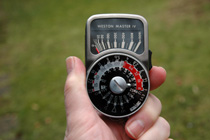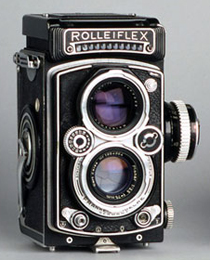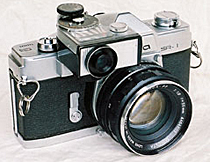|
Rolleiflex 75mm/3.5 Tessar
On 28 August 1962 I went by train to Copenhagen with the purpose of buying myself a used Rolleiflex. Two weeks earlier my second high school year had started and the reason that I still those many years after know the exact date is that I had fallen deeply in love with a tall, slim and most charming girl in my class. Her name was Elisabeth and that day it was her 17th birthday. The bad thing was that she was in no way in love with me.
End of that story: One and a half years later we began dating each other; in 1966 we married - and we still are and love each other.
|
|
Dark room
When I was
still living with my parents I had a dark room which I used a lot. B/W films were
Ilford F3 and HP3, later FP4 and HP4.
Enlarger was a Czechoslovakian Opemus 6x6 Standard. The rather poor lens was exchanged by one from Schneider Kreuznach.
|
But back to the Rolleiflex. Together with Erik, my best school comrade since 1st class I succeeded in finding a good and reasonably priced one.
It was with the four elements Zeiss Tessar lens. It had no light meter built in and accordingly I had to use a hand held light meter, a Weston Master IV, it was.

Weston Master IV light meter
|
Rolleiflex F 75 mm/3.5 Planar
In 1965 I sold it after having bought an even better and newer, hardly used Rolleiflex F with the high estimated Zeiss Planar f/3.5. In every respect is was a gorgeous camera.
Between 1962 and 1976 Rolleiflex was my preferred camera brand for black and white photography.
In 1982 I sold the F-model and that I often have regretted. Not that I should take any pictures with it, I should just like to have it.

Rolleiflex 3.5F with the famous Zeiss Planar lens and build-in light meter. A marveless and extremely well built camera. The problem was that the lens could not be eschanged.
Swedish Hasselblad was to become the leading mid format camera.
When I sold it I got almost four times as much for it as I had paid 17 years earlier. Inflation, I know it, but nevertheless. Today the price of a used 3.5 F is still higher than when I sold it 27 years ago.
|
Rolleiflex again
In December 2010 I bought a Rolleiflex Automat with Tessar 3.5/75 mm for my small collection
The production number is so close to that of my first Rolleiflex that they must have been made in the same month, probably June/July 1956. |
Minolta SR-1
1964-1975 I
was the owner of a Minolta SR-1 SLR. It wasn’t my dream camera, really, and I
never got any extra lenses for it, except for a rather bad 2x Soligor tele converter.
In fact I felt some kind of relief when it –
during a summer holiday – couldn’t take pictures any more. I had the Vitessa T with
me as a back up.

Minolta SR-1 with the cds-light meter SR-2 mounted. It coupled to the shutter speed wheel and you would adjust the aperture. Today we should call it S-mode.
Leica used the same technique on their M2 and M3 range finder cameras.
German Edixa couldn't use it due to an old fashioned focal plane shutter with two dials. - like on the Leica IIIG.
|